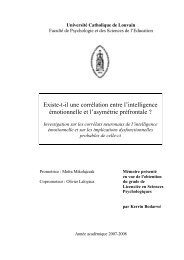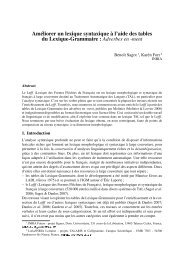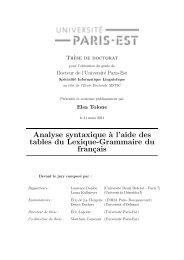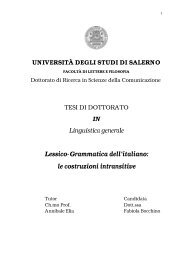Dream a little dream of me: Cognate Predicates in English
Dream a little dream of me: Cognate Predicates in English
Dream a little dream of me: Cognate Predicates in English
Create successful ePaper yourself
Turn your PDF publications into a flip-book with our unique Google optimized e-Paper software.
DREAM A LITTLE DREAM OF ME: COGNATE PREDICATES IN ENGLISH<br />
Comparable contrast<strong>in</strong>g views concern another construction, <strong>in</strong> which, unlike (1), the PVN is<br />
mandatory, as <strong>in</strong> (2):<br />
(2) It weighs nearly 27 kilos. (Cobuild)<br />
So<strong>me</strong> authors refer to the PVN <strong>in</strong> (1) as a ‘complé<strong>me</strong>nt <strong>in</strong>terne’ (Gougenheim 1964, Riegel<br />
1999, P<strong>in</strong>a Serrano 2004), whereas others term it a “cognate comple<strong>me</strong>nt” (Halliday 1967,<br />
Davidse and Ry<strong>me</strong>n 2006), or, more frequently, a “cognate object”. 3 As for the construction<br />
exemplified <strong>in</strong> (2), its PVN has been labelled as a “complé<strong>me</strong>nt de <strong>me</strong>sure” (still Riegel 1999,<br />
and references there<strong>in</strong>), or as a “<strong>me</strong>asure phrase”, MP, (e.g. Flick<strong>in</strong>ger and Bond 2003). 4<br />
Besides the controversial syntactic status <strong>of</strong> the PVN, CO and MP constructions are both<br />
characterized by the presence <strong>of</strong> two lexical items belong<strong>in</strong>g to dist<strong>in</strong>ct parts <strong>of</strong> speech (verb<br />
and noun), but related, however, either morphologically or through a hyperonym/hyponym<br />
relationship, which expla<strong>in</strong>s the reasons why the PVN <strong>of</strong> the clause-type <strong>in</strong> (1) has been<br />
ter<strong>me</strong>d ‘cognate comple<strong>me</strong>nt/object’ (e.g. to <strong>dream</strong> ↔ <strong>dream</strong>), or why analysts say that the<br />
PVN is a comple<strong>me</strong>nt that “re-labels” the verb (Halliday 1967). In (2), the lexical/semantic<br />
relationship between the verb and the PVN (to weigh ↔ kilo, to run ↔ mile) is dist<strong>in</strong>ct but<br />
also evident.<br />
Sentences such as He roared his thanks, from Huddleston and Pullum 2002: 305 (henceforth,<br />
H&P 2002) exemplify a third construction with an optional PVN, na<strong>me</strong>d Reaction Object<br />
(RO) by Felser and Wanner (2001), and with properties overlapp<strong>in</strong>g those <strong>of</strong> CO sentences.<br />
In the present analysis, the label identify<strong>in</strong>g CO sentences such as (1) needs to be re-worded,<br />
<strong>in</strong>s<strong>of</strong>ar as <strong>in</strong> this clause-type the noun and the verb can be regarded as cognate predicates. MP<br />
constructions <strong>in</strong>volve cognate predicates as well.<br />
Section 2 provides so<strong>me</strong> argu<strong>me</strong>nts to analyse COs as noun predicates, whilst section 3<br />
suggests a parallel between COs and ROs with regard to their predicative nature and the verbs<br />
with which they occur, <strong>in</strong> both cases analysed as supports. Section 4 succ<strong>in</strong>ctly targets MP<br />
constructions. The three clause-types all share double predication, regardless <strong>of</strong> the label with<br />
which this notion has been referred to: e.g. secondary predication, serial predication, e.g.<br />
serial verb constructions, or serialization as opposed to auxiliation (Rosen 1997). 5<br />
2. <strong>Cognate</strong> Objects as noun predicates<br />
In a sentence such as (3) the verb assigns the two boxers a syntactic role (SUBJECT OF) and a<br />
related thematic role (FIGHTER):<br />
(3) The two boxers fought.<br />
3 In the literature the label comprises pairs <strong>of</strong> words shar<strong>in</strong>g the sa<strong>me</strong> lexical morphe<strong>me</strong>, as <strong>in</strong> the title<br />
and <strong>in</strong> (1), but also verb/noun pairs with lexical roots <strong>in</strong>terpretable as hyperonym and hyponym respectively, e.g.<br />
dance a jig / a piece from Swan Lake. Jones 1988 claims the two types have dist<strong>in</strong>ct empirical properties. In<br />
these examples, the hyponym CO can be <strong>in</strong>terpreted as the “produit de l’action <strong>in</strong>transitive” (Safa 2004: 221).<br />
4 To a certa<strong>in</strong> extent, the different labels reflect a language divide: Francophone researchers who use the<br />
label objet <strong>in</strong>terne take <strong>in</strong>to <strong>little</strong> or no account the work done by those who use cognate object/comple<strong>me</strong>nt,<br />
mostly writ<strong>in</strong>g <strong>in</strong> <strong>English</strong>, and vice versa (compare e.g. the references <strong>in</strong> Riegel 1999 and P<strong>in</strong>a Serrano 2004 on<br />
the one hand, to those <strong>in</strong> Felser and Wanner 2001 and Davidse and Ry<strong>me</strong>n 2006 on the other).<br />
5 The predicative function <strong>of</strong> the PVN <strong>of</strong> COs is recognized <strong>in</strong> a number <strong>of</strong> works (e.g. Moltman 1989,<br />
Zhang 2005), but <strong>in</strong> none <strong>of</strong> these is the verb analysed as a support. To the best <strong>of</strong> my knowledge, the only<br />
exceptions are a few h<strong>in</strong>ts <strong>in</strong> Mittwoch (1998: 311), Riegel 1999, a paper that draws a parallel between COs and<br />
MPs, Safa 2004, and Ibrahim 2005.<br />
26 th conference on Lexis and Grammar, Bonifacio, 2-6 October 2007







